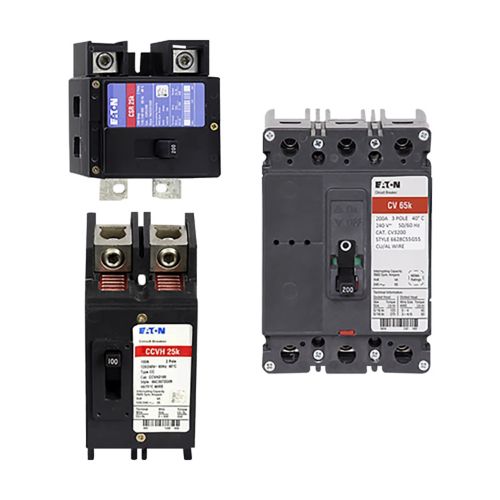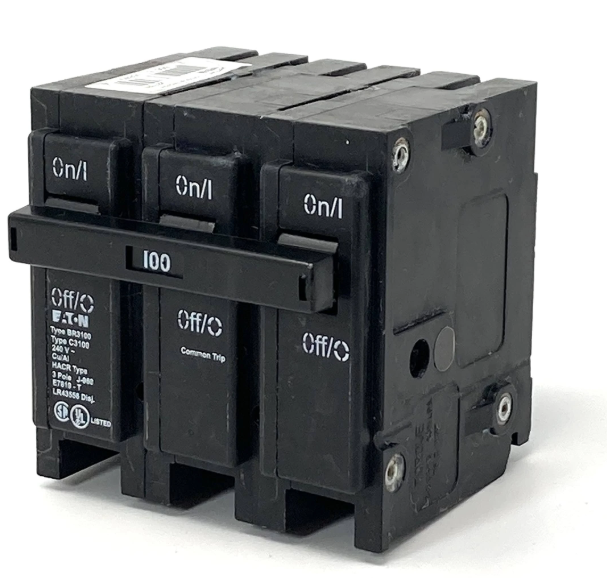5 key factors to select Eaton BR Circuit Breakers for safety, compliance and performance.
Need BR Type Breakers?
Get Eaton Miniature Breaker QuoteEaton BR circuit breakers protect light commercial and residential electrical systems. Choosing the right breaker from an Eaton Catalog is essential for safety, code compliance and long-term reliability.
Let’s explore what makes each factor critical and how it supports the safety and performance of your system.

1️⃣ Select the Eaton Breaker Type (Function)
Choosing the correct circuit breaker is important for the best electrical safety, compliance with codes, and best system performance. Eaton’s BR series offers a lot of options designed for light commercial and residential applications.
Eaton’s BR breakers come in different types, each designed for specific protection needs. Key factors you need to consider:
- Standard Thermal-Magnetic Breakers: These provide basic protection against overloads and short circuits.
- Arc Fault Circuit Interrupters (AFCI): Designed to detect and interrupt arc faults, which are unintended electrical discharges that can cause fires. AFCIs are needed for public areas for personnel safety.
- Ground Fault Circuit Interrupters (GFCI): These protect against ground faults, where electricity takes an unintended path to the ground, posing a risk of electric shock. GFCIs are crucial in wet areas like kitchens and bathrooms.
- Dual Function Breakers: Combine the features of AFCI and GFCI, offering comprehensive protection in a single device.
- Surge Protection Breakers: Protect your entire home from voltage spikes caused by events like lightning strikes or power surges.
- High-Interrupt Capacity Breakers (BRX): Good for environments with higher fault current levels, offering even more protection.
For more detailed information on Eaton’s breaker types, visit their BR Circuit Breakers page.
2️⃣ Select Eaton BR Circuit Breaker Amperage
The amperage rating of a Eaton BR Circuit Breaker breaker determines the maximum current it can handle without tripping. Selecting the right rating means your system works safely and efficiently.
- 15–20A: Good for general lighting and outlets.
- 30–50A: Meant for appliances like dryers and water heaters.
- 100A: Used for main breaker panels, electrical systems needing higher amperages
Always check the National Electrical Code (NEC) or a licensed electrician to determine the correct amperage for your specific application.
3️⃣ Select the Correct Eaton BR Breaker Pole Configuration
Pole configuration refers to the number of circuits a breaker can control:
- Single-Pole Breakers: Control one circuit and are typically used for 120V circuits.
- Double-Pole Breakers: Control two circuits and are used for 240V applications, including large appliances.
- Quadplex Breakers: Combine two double-pole breakers in a single unit, saving space in the panel.
Choosing the correct configuration gives compatibility with your electrical system and prevents potential hazards.
4️⃣ Match Voltage Rating and Interrupt Capacity
Breakers must match the voltage of your system and have an interrupt capacity that exceeds the potential fault current:
- Voltage Rating: Match the breaker’s voltage rating with your system’s voltage (e.g., 120/240V).
- Interrupt Capacity (AIC): This is the maximum fault current a breaker can safely interrupt. For standard residential applications, a 10kAIC rating is common. In areas with higher fault currents, breakers like Eaton’s BRX series, which offer up to 65kAIC could be needed.
Refer to Eaton’s Loadcenters and Circuit Breakers catalog for detailed Eaton BR Circuit Breaker specifications.
5️⃣ Electrical Panel Compatibility
Not all breakers are compatible with every panel. Eaton’s BR breakers are designed for BR load centers but are also UL-listed for use in certain Westinghouse, Challenger, and Bryant panels. Using a non-compatible breaker can lead to bad connections and potential safety hazards.
Always verify compatibility by checking the panel’s labeling or consult with a professional. For more information, see Eaton’s Residential Circuit Breakers page.
Quick Reference Chart for BR Breakers
| Type | Function | Amps | Poles | Voltage | AIC Rating |
|---|---|---|---|---|---|
| BR Standard (BR120) | Thermal Magnetic | 15–125 A | 1P, 2P, Quad | 120/240 V | 10 kAIC |
| BRCAF (BRCAF120) | AFCI Protection | 15–20 A | 1P | 120/240 V | 10 kAIC |
| BRD (BRDC215215) | Dual Function AFCI+GFCI | 15–20 A | 1P | 120/240 V | 10 kAIC |
| BRGF | GFCI Protection | 15–50 A | 1P, 2P | 120/240 V | 10 kAIC |
| BRX | High Fault Rating | 15–50 A | 1P, 2P | 120/240 V | 22–65 kAIC |
| BRESI (Surge) | Surge Protection | 15–50 A | 1P, 2P | 120/240 V | 10 kAIC |
By understanding these key factors: breaker type, amperage rating, pole configuration, voltage, interrupt capacity, and panel compatibility — you’re selecting the right Eaton BR circuit breaker for your application. This means safety, compliance, and best performance.
Choosing the right Eaton BR breaker doesn’t have to be complicated. By understanding breaker types, ratings, and panel compatibility, you’ll make safe, informed choices for your electrical system.
What You Should Know

Need help selecting or replacing an Eaton breaker? Contact us for guidance or check Eaton’s resources for full specifications.
